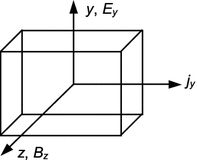Abstract
Metals are one of our most important sets of materials. The study of bronzes (alloys of copper and tin) dates back thousands of years. Metals are characterized by high electrical and thermal conductivity and by electrical resistivity (the inverse of conductivity) increasing with temperature.
Access this chapter
Tax calculation will be finalised at checkout
Purchases are for personal use only
Notes
- 1.
See Wigner and Huntington [5.32].
- 2.
See e.g. Marder [3.34, p. 277].
- 3.
The number of states per unit length with both spins is 2dk/2π and we double as we only integrate from Δ = 0 to kF or −kF to 0. We compute the derivative, as this is all we need in requiring the total energy to be a minimum.
- 4.
To be even more precise the phenomena and technical importance of electromigration is certainly real. The explanations have tended to be controversial. Our explanation is the simplest and probably has at least some of the truth. (See, e.g., Borg and Dienes [5.3].) The basic physics involving momentum transfer was discussed early on by Fiks [5.7] and Huntington and Grove [5.13]. Modern work is discussed by R. S Sorbello as referred to at the end of this section.
- 5.
See e.g. Huang [5.12]. See also Shapiro and Teukolsky [5.26].
Author information
Authors and Affiliations
Corresponding author
Problems
Problems
-
5.1
For the Hall effect (metals-electrons only), find the Hall coefficient, the effective conductance jx/Ex, and σyx. For high magnetic fields, relate σyx to the Hall coefficient. Assume the following geometry:

Reference can be made to Sect. 6.1.5 for the definition of the Hall effect.
-
5.2
(a) A two-dimensional metal has one atom of valence one in a simple rectangular primitive cell a = 2, b = 4 (units of angstroms). Draw the First Brillouin zone and give dimensions in cm−1.
(b) Calculate the areal density of electrons for which the free electron Fermi surface first touches the Brillouin zone boundary.
-
5.3
For highly relativistic conditions within a white dwarf star, derive the relationship for pressure p0 as a function of mass \( \overline{M} \) and radius \( \overline{R} \) using \( p_{0} = - \partial E_{0} /\partial V \).
-
5.4
Consider the current due to metal-insulator-metal tunneling. Set up an expression for calculating this current. Do not necessarily assume zero temperature. See, e.g., Duke [5.6].
-
5.5
Derive (5.37).
-
5.6
Compare Cu and Fe as conductors of electricity.
Rights and permissions
Copyright information
© 2018 Springer International Publishing AG, part of Springer Nature
About this chapter
Cite this chapter
Patterson, J.D., Bailey, B.C. (2018). Metals, Alloys, and the Fermi Surface. In: Solid-State Physics. Springer, Cham. https://doi.org/10.1007/978-3-319-75322-5_5
Download citation
DOI: https://doi.org/10.1007/978-3-319-75322-5_5
Published:
Publisher Name: Springer, Cham
Print ISBN: 978-3-319-75321-8
Online ISBN: 978-3-319-75322-5
eBook Packages: Physics and AstronomyPhysics and Astronomy (R0)


